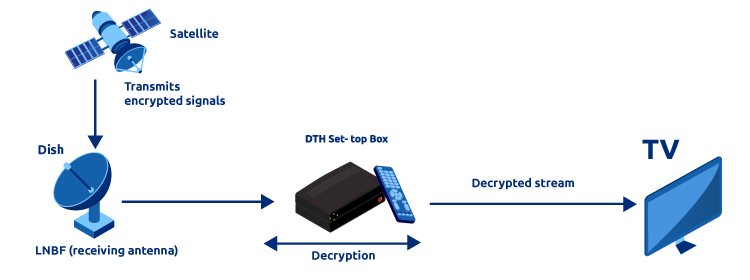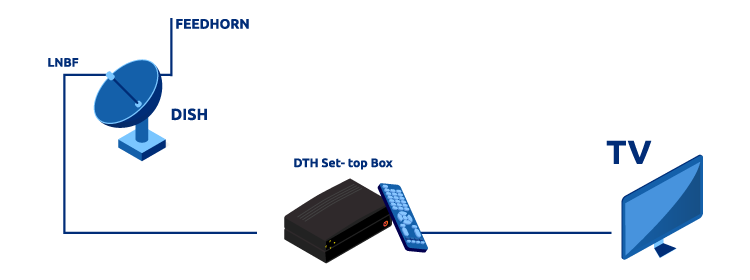How To Increase DTH Satellite Signal Strength?

Are you facing issues with your DTH satellite signal strength and looking for ways to enhance it? In this guide, we will explore practical tips and techniques to boost your DTH signal reception. Whether you're experiencing signal disruptions during bad weather or seeking better overall performance, understanding how to increase DTH satellite signal strength can significantly improve your viewing experience.
What is the difference between broadcast and direct-to-home?
There are two different types of signals: broadcast and direct-to-home (DTH). Broadcast satellites are used to distribute television signals over large areas, whereas DTH satellites serve individual households. In order for a DTH system to function properly, it requires a strong satellite signal that can be received by all subscribers.
What is DTH?
DTH is a system of broadcasting television signals directly to the home without any cable or satellite dish. DTH is a digital service and can be used in India and other countries, where there are no high-speed Internet connections available. DTH subscribers receive all their channels via an aerial or by using their set-top box (STB).
What is DTH full form?
DTH stands for "Direct-To-Home." Popular DTH service providers include companies like Tata Play, Airtel Digital TV, Dish TV, and Videocon D2H.
The STB receives all signals from various broadcasters across India, who then distribute them to individual households via fiber optic cables or microwave links that connect homes with each other over long distances. DTH services have been around since 1993 when Tata Play introduced it as an alternative way for viewers to get access to popular TV shows without having to install expensive equipment such as receivers/cables etc.
How does Direct to Home Technology Work?
Satellites are located approximately 35,700 kilometers above the Earth’s surface. The satellites transmit signals to broadcast stations on Earth’s surface. The broadcast center receives the signals, and transponders on the satellite help to establish communication channels between transmitting and receiving units. The satellite rebroadcasts these encoded signals, which are combined by multiplexers into digital format.

Understanding DTH Signal Basics
How Does a Strong DTH Satellite Signal Impact Content Quality?
Having an stable satellite signal is extremely important when it comes to enjoying high quality content, on your TV. The strength and stability of this signal directly impact the clarity, resolution and reliability of the channels you receive. When you have a satellite signal for, to home (DTH) transmission it ensures that the digital information sent by the satellite reaches your set top box without any interruptions. This ultimately leads to a viewing experience.
The importance of a signal becomes more evident in challenging weather conditions or areas where there might be potential interference as it helps minimize disruptions and ensures consistent delivery of content.
How To Set DTH Signal?
Setting up your DTH (Direct-To-Home) signal involves properly aligning your satellite dish to receive the satellite signals accurately. Here is a general guide on how to set up your DTH signal:
Choose an Appropriate Location
Select a location for your satellite dish that has a clear line of sight to the satellite. Avoid obstructions such as tall buildings or trees that may interfere with the signal.
Install the Satellite Dish
Mount the satellite dish securely on a stable surface, ensuring it is facing the correct direction towards the satellite. Refer to the user manual provided by your DTH service provider for specific installation instructions.
Connect Cables
Connect the coaxial cable from the LNB (Low Noise Block) on the dish to the input port on your DTH set-top box. Ensure all connections are tight and secure.
Power On the Set-Top Box
Turn on your DTH set-top box and your television. Follow the on-screen instructions to access the signal strength or signal setup menu. This can usually be found in the settings or installation section of your set-top box menu.
Access Signal Strength Menu
Navigate to the signal strength or signal setup menu on your DTH set-top box. This menu may vary depending on the brand and model of your set-top box.
Adjust Elevation and Azimuth
Fine-tune the elevation and azimuth settings on the dish. Elevation refers to the vertical angle, and azimuth refers to the horizontal angle. Refer to the specific values provided by your DTH service provider for your geographical location.
Monitor Signal Strength
As you make adjustments, monitor the signal strength or quality on your TV screen. Some set-top boxes provide a signal bar or numerical value indicating the strength of the signal.
Optimize Signal Quality
Adjust the dish position until you achieve the highest possible signal strength and quality. This may involve making small, gradual movements to the elevation and azimuth settings.
Secure the Dish
Once you have optimized the signal, secure the dish in its final position. Tighten all bolts and ensure that the dish is stable.
Perform a Channel Scan
After setting up the signal, perform a channel scan on your DTH set-top box to ensure that you can access all available channels.
What Are The Components of DTH Technology?
DTH (Direct to Home) System consists of the following components:
- Dish Antenna
- LNBF (Low Noise Block Down Converter plus Feedhorn)
- Coaxial Cable
- Set-Top Box

For example, if you are watching TV while at home but want to watch it on your phone or tablet, then you will need to use an antenna with a digital tuner. Those who live in urban areas can also watch their favorite shows on their smartphones by using apps like Netflix and Amazon Prime.
What is the difference between signal strength and signal quality?
Signal Strength/Intensity is a measure of the working power from DC voltage supplied to the LNB. High signal strength does not necessarily mean that a television station is being received. The quality of the data being sent by the LNB is what matters most.
Signal Quality is the amount of good data received and sent by the LNB. High signal quality means clear picture and sound without any disturbances.
DTH (Direct to Home) Technology Architecture
To understand how the DTH technology works, you need to understand the system, we must first know that what the technology architecture is and how it works:
Two Bands to transmit Satellite Signals
There are two bands used to transmit satellite signals. The Ku band and C band.
The Ku band: It is used to transmit signals from earth to satellites. It has a frequency of 24 GHz and the channels can be up to 12 GHz wide. This means that a single transponder will handle up to 12 channels at once, but there are also multiplexers that allow you to add more channels onto your transponder if needed (upwards of 56).
The C band: It is used to transmit signals from satellites to earth. It has a frequency range of 5 GHz and can be up to 2 GHz wide. This means that a single transponder will handle up to 2 channels at once, but there are also multiplexers that allow you to add more channels onto your transponder if needed (upwards of 32).
DTH - The Ultimate Way to Watch TV!
How To
Unleash the power of DTH and take your TV viewing experience to the next level.
Manage Your DTH PlansCompare DTH Providers
Compare DTH providers and choose the best experience to watch TV !
The compression standards used for broadcasting DTH signals
The compression standards used for broadcasting DTH signals are MPEG-2, MPEG-4 and H.264. These three types of compression algorithms can be used to transmit the same amount of data with a smaller number of bits, which means that you will get better quality when compared to other methods like CIF or QAM modulations.
Which Satellites Are Being Used by Indian DTH Operators?
As you know, Indian DTH operators use geostationary satellites to send their signals. They also have an option to use foreign satellites as well.
| Satellite: INSAT 4A | Operated and owned by ISRO, it was launched on 22/12/2005 | ||
|---|---|---|---|
| Mission Life (years) | Geostationary position | Number of Ku band Indian transponders | Operators using the satellite |
| 12 | 83° East | 12 | Tata Play DTH |
| Satellite: GSAT 10 | Operated and owned by ISRO, it was launched on 29/09/2012 | ||
| 15 | 83° East | 12 | Tata Play DTH |
| Satellite: ST 2 | Operated and owned by SingTel, it was launched on 20/05/2011 | ||
| 15 | 88° East | 12 | Videocon D2H |
| Satellite: MEASAT 3 | Operated and owned by MEA Satellite systems, it was launched on 11/12/2006 | ||
| 15 | 91.5° East | 13 | Reliance digital TV and Sun direct DTH |
| Satellite: NSS 6 | Operated and owned by SES world skies, it was launched on 17/12/2002 | ||
| 15 | 95° East | 12 | Dish TV |
| Satellite: GSAT 15 | Operated and owned by ISRO, it was launched on 10/11/2015 | ||
| 12 | 93.5° East | 24 | DD free dish and Sun Direct |
| Satellite: Asiasat 5 | Operated and owned by Asiasat telecom, it was launched on 11/08/2009 | ||
| 15 | 95° East | 12 | Dish TV |
| Satellite: SES 7 | Operated and owned by SES world skies, it was launched on 16/05/2009 | ||
| 15 | 108.2° East | 12 | Airtel Digital TV |
6 Ways to Improve the Signal Strength of Your DTH Satellite
Follow the few of the best recommended tips to increase the satellite signal quality for DTH:
Troubleshoot for Increase Satellite Signals
First, you should troubleshoot the problem yourself by adjusting your dish antenna in the right position. Align your DTH antenna and move it slowly-slowly in right and left direction and same up and down. If you are not able to increase DTH signals, then check for problems with these parts and accessories of your DTH connection.
If you’re still facing issues, check each component of your DTH connection:
LNB
The LNB is a critical component in receiving satellite signals. It converts GHz satellite signals to MHz so that set-top boxes can decode music and video. To check the quality of the signal, slowly rotate the LNB left and right while watching a channel. Only certified LNBs are guaranteed to work properly with your satellite receiver, so be sure to buy from a reputable dealer online.
Digital TV Antenna
The dish antenna must be tightened with the screw due to high wind force. If your dish antenna is not properly anchored, it will not receive adequate amplification from the satellite. You can secure your dish antenna to the walls and floor with newer fasteners and inspect the DTH antenna’s rear screws and nuts.
Replace / Clear Connectors
Remove the LNB connector from the set-top box and trim any excess wire. Then connect the wires in a clockwise direction around the LNB.
Coaxial cable
If you are getting weak signals, check the coaxial cable. If you can’t figure out what’s wrong with the cable, replace it. Because if you don’t, it can cause internal damage that we are unable to detect.
Others
Alternatively; to improve the signal strength of your DTH satellite, use a signal booster for DTH. It is a small device that boosts the signals from your DTH satellite and amplifies them so that they can be received properly by your television set or receiver. There are many different types of boosters available in the market today, but we recommend using one with an external antenna because it helps improve both indoor and outdoor reception quality.
What External Factors Boost DTH Signal Strength?
The strength of a signal can vary depending on many factors including weather conditions, location and interference from other sources. Some of these factors include:
- The location of the dish and how it's aligned to the satellites (the angle at which it points).
- The type of antenna you use.
- The environment around the dish and how far away from other objects, like buildings or trees, they are located in relation to one another.
DTH Signal Quality: Frequently Asked Questions
Does a Larger Dish Guarantee Better DTH Picture Quality?
A larger dish does not improve clarity if the signal strength is already at its maximum level. The DTH company technician ensures optimization of signal strength during installation.
How Do Environmental Factors Affect DTH Signal Reception?
Two main types of disruptions in DTH signal occur due to environmental factors: rain outage and sun outage. Rain outage occurs when heavy rains absorb high frequency microwaves coming from the satellite and cause temporary loss of signal. Sun outage occurs intermittently during Equinoxes when the sun's radiation overpowers and interferes with the signals from satellites.
How Do You Check Signal Strength in d2h?
Start by pressing the menu button on your remote. Navigate to the Setup option and select "Installation." When prompted, enter the code 1234. Proceed to "Box Settings" and then select "Satellite Management." To refine your signal settings, enter the 4th, 6th, 8th, and 10th digits of your smartcard number. This will lead you to a menu where you can make specific adjustments to optimize the satellite signal.
How To Fix Signal Strength in Airtel Digital TV?
To fix signal strength in Airtel DTH, switch on your Airtel Android Box, turn on the smart TV, select the menu button, and choose "Point Dish" for system setup. Select the installation button, set the satellite number to 119, and the transponder to 11. Watch for the signal strength to update; a green signal box indicates a successful connection. In case you still face issues, call Airtel DTH customer care or SMS @121.
Browse DTH Connections
